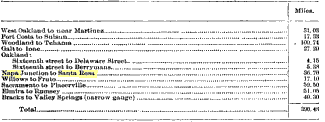Northern Railway
| Founder |
| Unknown |
| Founded |
| May 4, 1888 |
| Operated |
| May 15, 1888 to April 14, 1898 |
| Predecessor |
| Santa Rosa & Carquinez Railroad |
| Predecessor |
| ... |
| Disposition |
| Consolidated on April 14, 1898 |
| Successor |
| Southern Pacific |
History
On May 31, 1888 the 36.7-mile line from from Napa Junction to Santa Rosa, referred to as the "Santa Rosa Branch" and later the "Sonoma Valley Branch" was completed by the Northern Railway Company. On April 14, 1898 the Northern Railway was merged into Southern Pacific. "From the earliest, it was Mark McDonald of Santa Rosa, who worked with the Central Pacific, later Southern Pacific, to connect with lines that would get his fruit to the eastern market, rather than railroad lines that headed only to San Francisco."1.
The following is from the "Report on the internal commerce of the United States for the Year 1890 - Part II of Commerce and Navigation: The commercial, industrial, transportation and other interests of Alaska, Arizona, California, Idaho, Nevada, Oregon, Utah and Washington" By S. G. Brock, Chief of the Bureau of Statistics, Treasury Department, Washington, Government Printing Office, 1891:
"This road, which forms a system of nearly 400 miles of railway and is among the most important of the lines controlled by the Southern Pacific Company, was organized July 19, 1871, and opened its line for traffic from Woodland, the junction point with the California Pacific Railroad, to Williams, July 1, 1876; from Williams to Willows, October 3, 1878; to Orland, July 31, 1882; to Tehama, the junction point with Central Pacific Railroad, September 27, 1882. From West Oakland to Shell Mound the road was opened August 16, 1876; to Martinez, January 9, 1878; to Suisun, December 28, 1879, joining there the California Pacific Railroad, and forming a short line from San Francisco to Sacramento, in connection with the ferry system of the Central Pacific Railroad. At Port Costa extensive wharves were built, and a ferry established to transfer freight and passenger trains across the Straits of Carquinez to Benicia. For that purpose the steamer Solano was constructed, which is one of the largest ferry steamers in the world, having a tonnage of 3,550 tons. In 1888 the increase in traffic between West Oakland and Port Costa necessitated the construction of a second track, which was completed and put in operation November 1, 1888.
"On May 15, 1888, the Northern Railway was consolidated with the Winters and Ukiah Railway, Woodland, Capay and Clear Lake Railroad. West Side and Mendocino Railroad, Vaca Valley and Clear Lake Railroad, San Joaquin and Sierra Nevada Railroad (narrow gauge), Sacramento and Placerville Railroad, Shingle Springs and Placerville Railroad, Santa Rosa and Carquinez Railroad, Amador Branch Railroad, and Berkeley Branch Railroad, forming the Northern Railway Company. The lines of this road are wholly located in California, and the mileage at the present time is as follows:
"There are also 28.28 miles of second track. All of the above are standard gauge, with the exception of the line from Bracks to Valley Springs, which has a gauge of 3 feet."
Description and history.
Lines and Depots
Map
See Also
- Railroads
- Santa Rosa & Carquinez Railroad
- Sonoma Valley Railroad
- Poor's 1878, pg. 917.
- Poor's 1880, pg. 893.
- 1876 California PUC report.
- Daily Evening Bulletin, November 6 to December 27, 1875, San Francisco.
- Yolo Mail, July 8, 1875 to July 6, 1876, Woodland.
- The Yolo Democrat, September 17 to November 5, 1875, Woodland.
- The Yolo Democrat, January 28 to July 13, 1876, Woodland.
References
- Donald B. Robertson, Encyclopedia of Western Railroad History: California, Volume 4 (1998).



